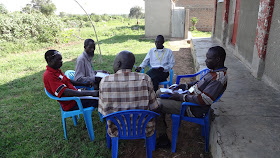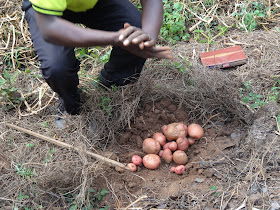By Sara:
I recently had the opportunity to visit a very different
part of the country from Soroti - Kabale. Kabale is located in the far
southwest corner of Uganda, right next to the Rwanda border. It is
hilly, densely populated, and much cooler than Soroti (I slept under
blankets at night and needed to wear a sweater in the mornings and
evenings!). I was there with World Renew staff to do an evaluation of
the projects World Renew supports in that region.
Taking part in
evaluations of World Renew projects is part of my job here. Basically, in an evaluation, a group of people both from World Renew Uganda and from outside Uganda or outside World Renew, go and visit the actual participants/beneficiaries involved in projects, asking questions about how they have been affected by the programs and seeing what exists on the ground, then also meet with the program staff to see how they are doing in their work. This helps to avoid problems, for example if a project is supported financially, but nothing is in reality being done. Since World Renew does its work much of the time through supporting partner organizations, evaluations are part of the accountability. In an evaluation, we also offer ideas for improving the project and future projects, and it is a learning experience for everyone participating to learn about what is working or not working in development. For this
evaluation in particular, since I have knowledge about agriculture, I
was especially able to help the team in looking at the way the agricultural
project is going there and in giving suggestions about how to continue
that work well.
In
Kabale, there is a health/HIV project, a village savings and loans
(VSL) project, and an agricultural project (conservation agriculture).
Since I am focusing on agriculture in my work here, in this post I am
also going to talk mostly about the agriculture I saw going on in
Kabale.
First of all, here is some of the beautiful scenery:
A strong focus of the conservation agriculture program in Kabale is mulching and crop rotation. Since most people only have a small amount of land, they have been constantly growing crops on that land, often the same crop season after season. As a result, soil fertility has steadily been decreasing. Mulch helps prevent erosion (which causes fertility to be lost) and adds nutrients to the soil. Rotating crops also helps to keep the soil healthy. So below is the home of Violet, one of the participants in the conservation agriculture program. You can see how she mulched everything. This might not seem like a big deal, but when land is scarce, it takes effort to find unused plant material for mulch.

Here Violet is showing how the mulch has improved her soil and how she doesn't have to work hard to weed since the weeds are not growing through the mulch. She also mentioned how her banana plants have become healthy and are not yellow or stunted like those of her neighbors. The basket of potatoes is a small part of her harvest this year.
She is also a volunteer for Kabale's program working with orphans and vulnerable children. For that program, they taught some children about keeping rabbits so Violet started keeping rabbits too. She said that she used to think that meat was only for rich people, but now that they keep rabbits, they have meat whenever they want it.
We walked up and down lots of beautiful hillsides. It was great!
We visited another woman, Vasta, who has been mulching her garden for three planting seasons. She planted potatoes on no more than 1/4 acre and the first time she harvested 8 sacks (and these are sacks about as tall as I am). Then, she grew beans and the third season she went back to potatoes again and harvested about 13 sacks!
The picture below shows about half of her field
We visited Jopista, a lady from the Village Savings and Loans program who used a loan to buy materials to make these lovely mats to sell. With the profits, after she pays back the loan, she plans to hire someone to farm her land for her.
Here are some of the other participants in the programs:
The woman whose home we were at, Beatrice, showed us the great things that mulching and crop rotation are doing for her. She is growing green peppers.
So far, she has been able to harvest peppers four times from the plants that were mulched. The unmulched plants (on the top right side of the picture below), which were planted at the same time, haven't produced enough to be harvested from even once yet.
She also planted potatoes. She mulched half of the garden and left the other half unmulched (this is the first season she has mulched that garden at all). While we watched, she dug up on plant from the mulched garden and one from the unmulched garden. The picture below shows the potatoes from the mulched plant. You can see how big some of them are compared to that planner in the corner.
And then the potatoes from the unmulched plant below - all tiny.
Here, she is holding all of the potatoes from the unmulched plant in one hand. It would have been hard to fit all of the potatoes from the mulched plant in two hands!
Mulched beets:
A happy pig:
Tree tomatoes - a super interesting plant:
One of the things that Beatrice and others are doing to add value to their crops is to make potato chips (or crisps, as they are called in Uganda - chips are fries). Here she is showing how she slices the potatoes.
On another day, I went with one of my World Renew colleagues, Allen (far right in the picture below) to visit a family who is part of a VSL group. We climbed up a steep hill to get to their home.
This family borrowed money to buy tree tomato seeds. You can see the nursery beds for the seedlings below. He bought the seeds and fertilizer for 50,000 shillings and has so far earned about 4 million shillings by selling the fruits across the border in Rwanda!
Here is the banana/tree tomato/cocoyam forest:
The family's savings group also planted a field of cabbages together to earn money as a group. Everyone participates in the work of caring for the garden.
This is the beautiful path we followed to get to the hill in the distance, which we climbed.
There is a pile of bricks covered by a blue tarp about a quarter of the way below the middle of this picture. That is where we went.
Later, we went to a community meeting with participants from all the different programs. Some men sang us a super enthusiastic song full of dancing and jumping. I only caught the end of it on video, but it was great.
So basically, World Renew is supporting great work in Kabale. I'm glad I got to go and hear the stories and see the changed lives there!
































































